Walking in Bangkok: back in time
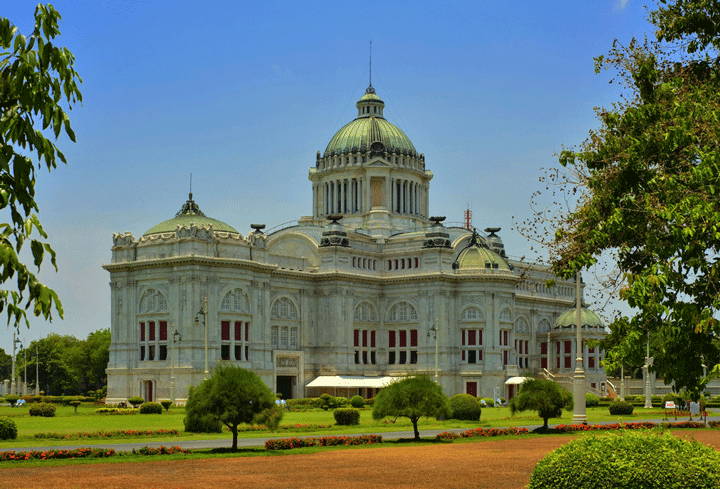
Ananta Samakhom Throne Hall
I was in a while ago Bangkok to meet a friend from the Netherlands. He was staying in a hotel in an area I had never been to and I had a motosai take me there from Siam Square. After my visit I decided to return walkn. I didn't know the way, but I knew which direction to go. So I set off and thought, if I've walked long enough and haven't reached my goal yet, I'll take another motosai, which can drop me off at a BTS station somewhere.
My journey on foot started near Khao San Road, a nice and busy area with all kinds of shops and restaurants, I didn't allow myself to stay long because I had to move on. I walked through long streets and saw buildings on the left and right, often in a kind of garden and enclosed by high walls. I didn't take much interest in them, because they were just buildings, weren't they? I passed by without realizing the background or history of those buildings.
Somewhat surprisingly, I recently read an article in The Nation, which describes a walking tour in the Dusit district past palaces and temples and in the photos I recognized some of those buildings, I had walked past them on my trip. It turns out to be the historical heritage of the City of Angels and with a guided tour from the Thai Tourism Society, those buildings come to life, so to speak.
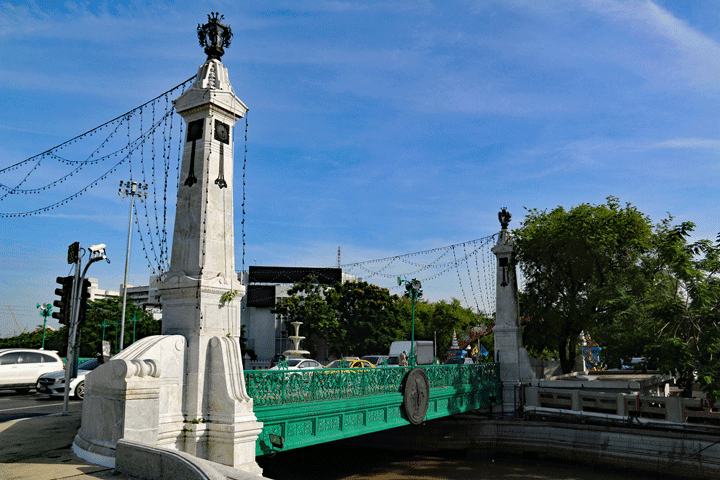
Makkawan Bridge (Idealphotographer / Shutterstock.com)
A journalist from the newspaper participates in this walk, prompted by an announcement from the Society on their Facebook page. About 50 people, who do not know each other, form the group for the walking tour. It is 9 am on a Sunday morning when the group gathers at the Makkawan Bridge. This free trip was therefore organized by the Thai Tourism Society and aims to improve the knowledge of the residents of Bangkok of their city and to bring together interested parties through the use of social media.
This walking tour is a walk in Dusit district, the first urban district of Bangkok and the journalist Phoowadon Duangmee made a report which is summarized below.
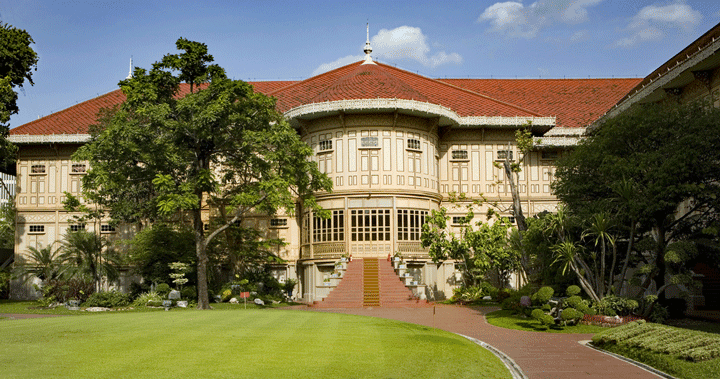
Vimanmek–Dusit Palace
Preface
Before King Chulalongkorn (King Rama V) ascended the throne, all royal affairs took place in the Grand Palace. The Inner Court was home to the Royal Family, while the country's business issues were discussed in the Middle and Outer Courts. Eventually, the Grand Palace would become too small to accommodate all the wishes of members of the royal family.
When King Chulalongkorn returned from Europe to Siam in the late 19th century, he began to turn his ideas into reality, inspired by what he had seen in the great capitals of the west. One of his first acts was to buy orchards and rice fields between Khlong Padung Krungkasem and Khlong Samsen to grow flowers there. He called the area “Suan Dusit” or Dusit Garden. He then built a new palace, Vimanmek, which served as the new royal residence. The king really liked his new palace and he often cycled between the Grand Palace and Vimanmek. His cycle route eventually became Rajdamnoen Avenue.
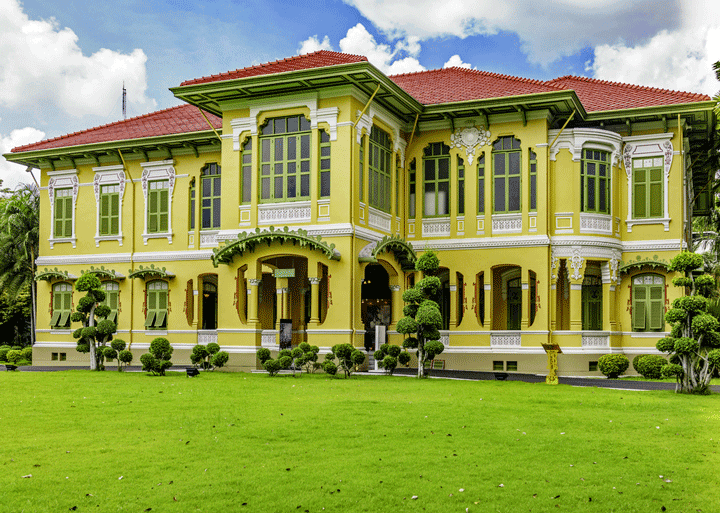
Paruskavan Palace (Sompol / Shutterstock.com)
The trip
“From Makkawan Bridge, we head north along Rajdamnoen Nok Avenue, then turn right onto Sri Ayutthaya Road,” begins Apivat Covintranon, a retired teacher who volunteers as a guide: “We will stop here and there at historical sites.”
So we make our way to the Ananta Samakhom Throne Hall along Rajdamnoen Avenue. A busy thoroughfare, lined with leafy tamarind trees, surprisingly quiet at this early hour on a Sunday morning.
We stop at the Ministry of Education, once the Chan Kasem Palace, which King Chulalongkorn had built for Crown Prince Vajiravudh. With the Royal Thai Army Guard 1 on our right we continue north. At the corner of Sri Ayutthaya Road and Rajdamnoen Avenue, our guide Apivat points out a mustard colored fence and olive green gate on the other side of the street.
“Paruskavan Palace,” says Apivat. “King Chulalongkorn had this palace built for his son, Prince Chakrabongse.
It is a stately mansion in the German baroque style. It was made famous by the autobiography of Prince Chula Chakrabongse, (son of Prince Chakrabongse and his Russian wife Catherine Desnitsky) titled “Kerd Wang Parus” or “Born in Paruskavan Palace” as it is known in English. The palace is now a Police Museum, open to the public from Wednesday to Sunday.
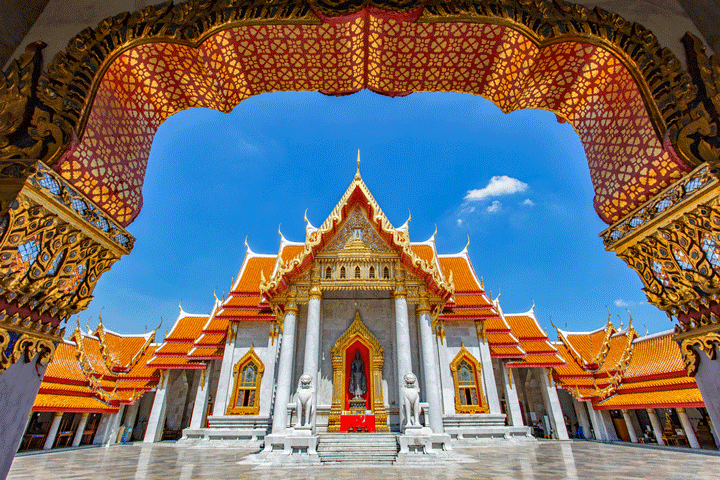
Wat benchamabophit
Turning right onto Sri Ayutthaya Road to the east, we come to Wat Benchamabophit, also known as the Marble Temple. Built in 1899, this temple is considered one of the most beautiful in the city. A hybrid of Thai and European architecture, it features Victorian-style stained glass windows depicting scenes from Thai mythology.
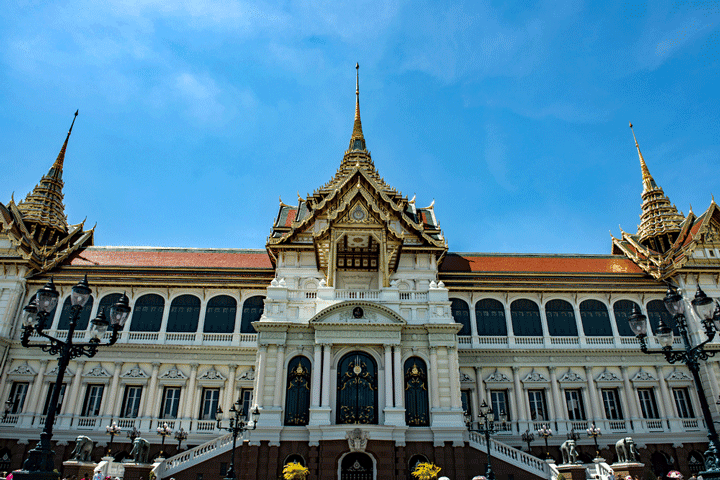
Chitralada Palace
Chitralada Palace
Dusit district is still a royal enclave, home to the Chitralada Palace, the residence of the current royal family. With the National Assembly north of Ananta Samakhom Throne Hall and Government House, south of Wat Benchamabophit, it is the center of political power.
From the back of Wat Benchamabophit, we walk back to Phitsanulok Road and then through Nakhon Pathom Road to the Panichyakan Junction, where the Chamai Maruchet Bridge crosses the Prem Prachakorn Canal. East of this canal is Rajamangala University of Technology Phra Nakhon, once the palace of one of King Chulalongkorn's sons, Abhakara Kiartivongse, Prince of Chumphon. In the west we see the Government House.
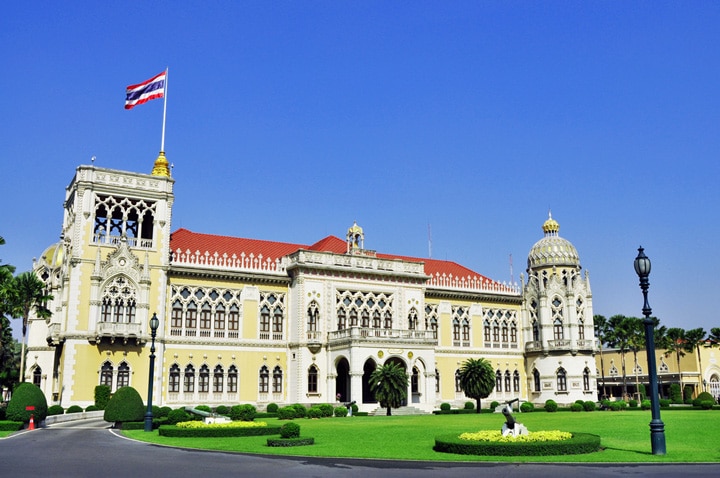
Government House
“The Government House was originally intended to be a family residence and was known as Baan Norasing,” says Apivat. “Vajiravudh, also a son of King Chulalongkorn, commissioned an Italian architect to build this massive Neo Venetian Gothic style mansion for his favorite general and right-hand man – Chao Phraya Ramrakhop.
“The Prince of Chumphon was not happy about this and closed the main gate of his palace on the canal and used the smaller gate on the side of Khlong Padung Krungkasem,” Apiva added.
Prince of Chumphon
We cross Phitsanulok Road and stop at the Shrine of the Prince of Chumphon. Born of a relation of King Chulalongkorn and a common lady of the Bunnag family, the Prince of Chumphon is the founder ("father") of the modern Thai navy. He is highly respected by Thai people for his courage and generosity as well as his use of medicinal herbs and love of the paranormal.
“People love him and many shrines have been built for him, but this shrine is the most beautiful,” Apivat finally says, for the journey has ended.
The group still walks past Khlong Padung Krungkasem and says goodbye to each other at the market of Nang Loeng.
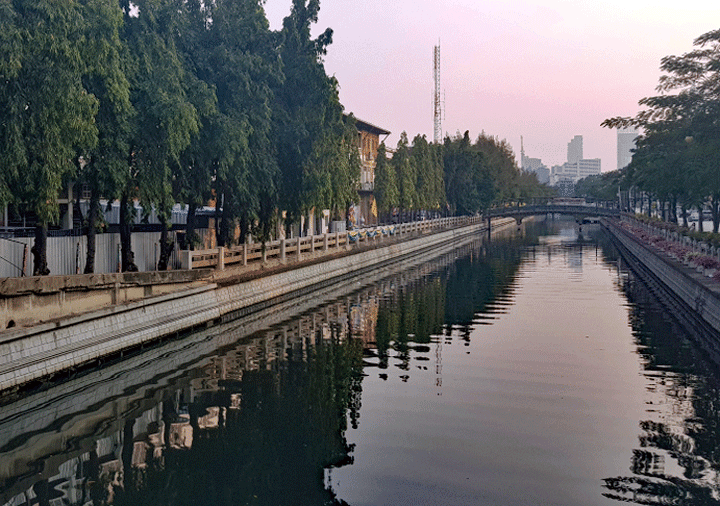
Khlong Padung Krungkasem
Finally,
Similar walking tours, accompanied by a guide, are organized more often by the Society, which are announced on its Facebook page. However, that Facebook page is only in Thai and I'm afraid that the guide in the walking tour described above also only spoke Thai.
No worries for you as a foreigner, Google “walking in Bangkok” and you will have many websites available about organized or non-organized walking tours and routes. Walking through Bangkok is, apart from the sometimes high temperatures, fun, surprising and interesting.
Source: The Nation


The police museum is not in the Paruskawan Palace (ตำหนักจิตรดา วังปารุสกวัน) but in a new building in the garden of the palace/villa. I went there this spring, I was received by an older gentleman, but he called in a nice history student who gave me a tour of the palace in good English. This building and some others like the palace that houses the Museum Siam were designed by an Italian architect whose name I forgot. Very nice to visit old stately buildings.
Gringo,
Here's a quote if you don't mind:
He then built a new palace, Vimanmek, which served as the new royal residence. The king really liked his new palace and he often cycled between the Grand Palace and Vimanmek. His bike route eventually became Rajdamnoen Avenue.'
That teak palace Vimanmek (meaning 'Palace in the Clouds') has been closed to visitors for a few years and I heard that it has been demolished in the meantime. Is that true? Do you know more about that?
On Google Maps satellite photos (from Jan. 2021?) it looks like the palace has been rebuilt again. Only the surroundings of the palace still need to be taken care of.
Wikipedia states that in July 2019, a palace official reported that the palace had been dismantled and would be rebuilt on a new foundation. It was also said to be permanently closed to the public. Unfortunately, this building has to be removed from the walking route.
The work would cost around ฿81 million (€2,1 million).
https://en.wikipedia.org/wiki/Vimanmek_Mansion
Quote:
'Dusit district is still a royal enclave, home to the Chitralada Palace, the residence of the current royal family. With the National Assembly north of Ananta Samakhom Throne Hall and Government House south of Wat Benchamabophit, it is the center of political power.'
Dusit in Thai script ดุสิต (doesit with two low notes) means 'The Fourth Heaven'. That's where the power resides.